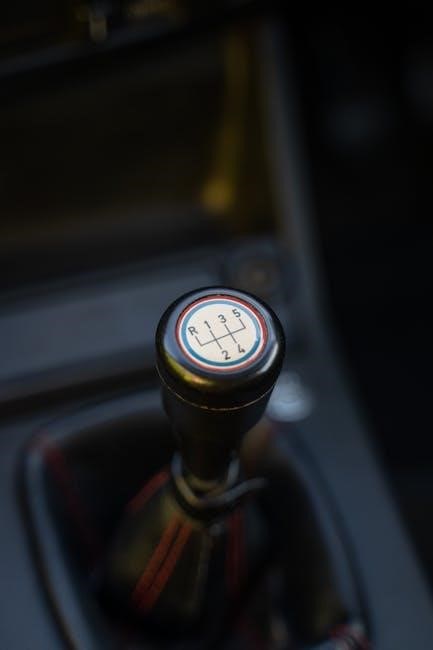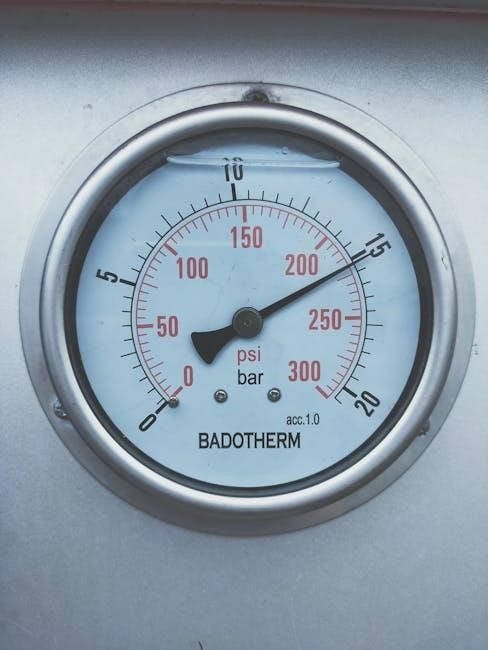The Mazda Miata’s manual transmission is renowned for its precise shifts‚ balanced clutch feel‚ and direct driver connection‚ embodying Mazda’s Jinba Ittai philosophy for an unparalleled driving experience.
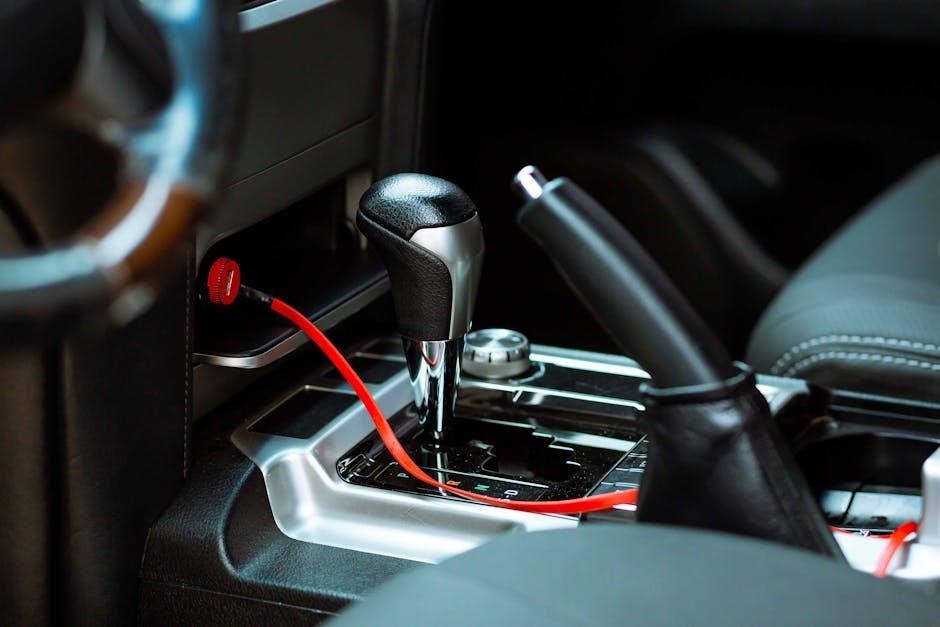
History of the Miata Manual Transmission
The Mazda Miata’s manual transmission has evolved through four generations‚ starting with the 5-speed NA‚ followed by the 5- and 6-speed NB‚ then the 6-speed NC‚ and finally the refined ND with enhanced features.
First Generation (NA) ⎼ 5-Speed Manual
The first-generation Mazda Miata‚ known as the NA‚ debuted in 1989 with a 5-speed manual transmission‚ paired with a 1.6-liter engine. This transmission was praised for its smooth‚ precise shifts and lightweight design‚ perfectly complementing the Miata’s agile handling. The NA’s manual gearbox became iconic for its simplicity and reliability‚ offering drivers a direct connection to the road. With gear ratios tailored to the engine’s power range‚ it excelled in both city driving and winding roads. The NA’s transmission laid the foundation for the Miata’s reputation as a driver-focused sports car‚ with its engaging and intuitive feel. Maintenance was straightforward‚ and the transmission proved durable‚ making it a favorite among enthusiasts.
Second Generation (NB) ⎼ 5-Speed and 6-Speed Options
The second-generation Miata (NB) introduced both 5-speed and 6-speed manual transmissions‚ starting from mid-2001. The 6-speed option‚ available in later models‚ offered closer gear ratios and improved performance. Both transmissions were known for their smooth operation and precise shifts‚ enhancing the driving experience. The 6-speed featured a more refined design‚ with better synchronization and a shorter throw shifter‚ making it a favorite among enthusiasts. The 5-speed remained a reliable choice‚ providing a balanced blend of fuel efficiency and responsiveness. The NB’s manual transmissions were praised for their durability and ease of maintenance‚ solidifying the Miata’s reputation as a driver-focused roadster. These options catered to a wide range of driving preferences‚ ensuring the Miata remained a versatile and engaging vehicle.
Third Generation (NC) ⎼ 6-Speed Manual
The third-generation Miata (NC) exclusively featured a 6-speed manual transmission‚ building on the success of its predecessor. This generation introduced refined gearing and improved shift precision‚ making it a favorite among enthusiasts. The NC’s 6-speed manual offered a more engaging driving experience‚ with closer gear ratios that enhanced acceleration and control. Mazda also introduced the SKYACTIV-MT technology‚ which optimized shifting smoothness and reduced weight. The transmission’s short-throw shifter and well-defined gates provided a sporty feel‚ aligning with the Miata’s reputation as a driver-focused roadster. Maintenance practices remained straightforward‚ with regular fluid changes and inspections recommended to ensure longevity. The NC’s manual transmission further solidified the Miata’s legacy as a car designed for pure driving enjoyment.
Fourth Generation (ND) ─ 6-Speed Manual with Improved Features
The fourth-generation Miata (ND) continued to refine the 6-speed manual transmission‚ introducing enhanced features for a more precise and engaging drive. Mazda incorporated its SKYACTIV-MT technology‚ which optimized shifting smoothness and reduced weight. The ND’s manual transmission featured a short-throw shifter and refined gear ratios‚ allowing for quicker acceleration and better control during spirited driving. Additionally‚ Mazda introduced a more robust lubrication system to improve durability and reduce wear. While the ND’s transmission was praised for its performance‚ some owners noted the importance of regular fluid changes to maintain optimal functionality. These improvements solidified the ND Miata’s reputation as a driver-centric roadster‚ embodying Mazda’s commitment to the manual transmission’s enduring appeal.
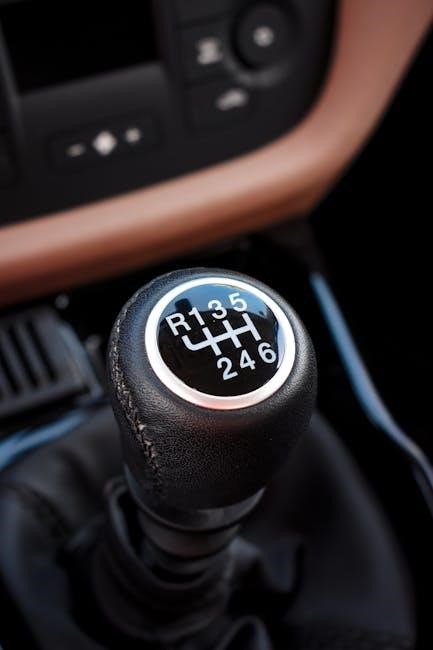
Technical Details of the Miata Manual Transmission
The Miata’s manual transmission features precise gear ratios‚ durable components like bearings and synchros‚ and a robust lubrication system to ensure smooth‚ reliable operation and longevity.
Gear Ratios and Their Impact on Performance
The Mazda Miata’s manual transmission features strategically designed gear ratios that optimize performance across various driving conditions. Earlier models‚ such as the NA and NB generations‚ utilized 5-speed transmissions with closer ratios for spirited driving‚ while later ND models introduced 6-speed transmissions with an additional overdrive gear for improved highway efficiency. The precise calibration of gear ratios ensures smooth acceleration and responsive shifting‚ allowing drivers to maximize the engine’s power band. This design enhances the connection between driver and vehicle‚ delivering a more engaging and dynamic driving experience. The evolution of gear ratios reflects Mazda’s commitment to balancing performance and practicality‚ making the Miata a standout in its class.
Components of the Miata Manual Transmission
The Miata’s manual transmission is composed of several key components that work harmoniously to deliver precise and smooth shifting. At its core is the gearbox‚ which houses the gear sets‚ bearings‚ and synchronizers. The clutch assembly‚ including the clutch disc‚ pressure plate‚ and release bearing‚ facilitates smooth engagement and disengagement of power. The shift fork and selector rods are responsible for guiding the gears during shifts‚ while the transmission fluid lubricates and cools the internal components. Additionally‚ the speed sensor and reverse lockout mechanism ensure accurate gear selection and safety. These components are engineered to withstand the rigors of performance driving while maintaining the Miata’s reputation for reliability and driver engagement.
Lubrication and Maintenance Best Practices
Proper lubrication and maintenance are crucial for the longevity and performance of the Miata’s manual transmission. Regular transmission fluid changes are essential‚ typically recommended every 30‚000 to 60‚000 miles‚ depending on driving conditions. Use high-quality‚ Mazda-approved transmission fluid to ensure optimal lubrication and prevent wear on internal components. Inspect the clutch and gear components periodically for signs of wear or damage. Address any leaks promptly to avoid contamination and costly repairs. Additionally‚ avoid extreme temperatures and harsh driving conditions that may stress the transmission. Proper maintenance not only enhances performance but also prevents premature wear‚ ensuring the Miata’s manual transmission continues to deliver its signature precise and engaging driving experience. Regular servicing is key to maintaining its reliability and responsiveness.

Driving Dynamics and Performance
The Mazda Miata’s manual transmission delivers exceptional driving engagement‚ with smooth‚ precise shifts and a responsive clutch. Its design enhances the connection between driver and car‚ offering thrilling performance.
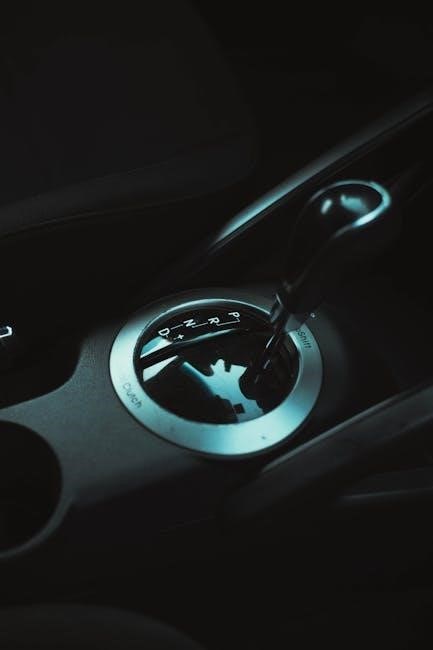
The Engagement and Precision of the Manual Shift
The Mazda Miata’s manual transmission is celebrated for its exceptional shift precision and engagement‚ offering a tactile driving experience. The short-throw shifter in later models‚ such as the SKYACTIV-MT 6-speed‚ enhances the connection between driver and car. Each gear change is crisp and deliberate‚ providing mechanical feedback that elevates the joy of driving. The clutch pedal’s balanced feel complements the shifting process‚ making it both intuitive and rewarding. This precision contributes to the Miata’s reputation as a driver-focused vehicle‚ delivering a seamless link between the driver’s inputs and the car’s responses. The manual shift’s engagement is a key factor in the Miata’s enduring appeal among driving enthusiasts.
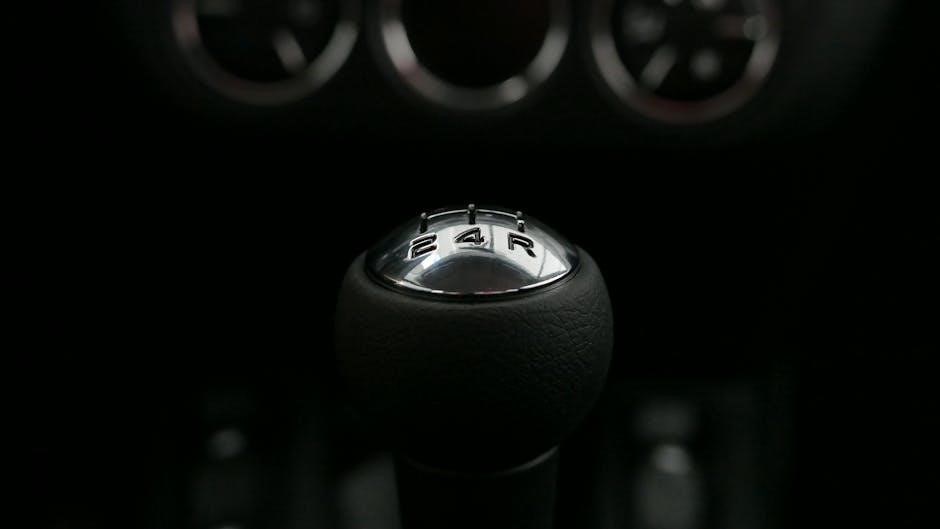
Common Issues and Solutions
The Miata’s manual transmission can experience issues like worn synchros‚ bearings‚ and gear wear. Regular fluid changes and component inspections are essential for maintaining performance and longevity.
Common Problems with the Miata Manual Transmission
The Mazda Miata’s manual transmission‚ while praised for its performance‚ can encounter specific issues. One common problem is synchro wear‚ particularly in higher-mileage vehicles‚ leading to difficulty engaging gears. Bearings may also degrade over time‚ causing noise or vibration during operation. Additionally‚ some owners have reported issues with the transmission’s gear ratios‚ especially in the 2016 ND models‚ which required replacements due to design flaws. Transmission fluid degradation is another concern‚ as it can lead to sluggish shifting if not replaced at recommended intervals. Regular maintenance‚ such as fluid changes and inspections‚ can help prevent these issues. Rebuilding or replacing the transmission may be necessary in severe cases‚ ensuring optimal performance and longevity.
Symptoms of Transmission Wear and Tear
Owners of the Mazda Miata may notice several symptoms indicating transmission wear and tear. Grinding or crunching noises during shifts‚ particularly when engaging first or second gear‚ are common signs. Difficulty shifting into gear‚ especially when cold‚ can signal worn synchronizers or bearings. A humming or whistling noise while driving may indicate bearing degradation. Additionally‚ vibrations during acceleration or deceleration could point to misaligned or worn components. Some drivers have reported a “stubborn” feel when shifting‚ suggesting potential issues with the transmission’s internal parts. Regular maintenance‚ such as fluid changes and inspections‚ is crucial to identify and address these issues early‚ preventing costly repairs and ensuring smooth operation.

Transmission Swap Guide
Converting an automatic Miata to manual requires a compatible transmission‚ such as the 89-05 unit‚ and specific tools like a clutch kit and shift linkage.
Manual Transmission Swap for an Automatic Miata
Swapping an automatic Miata to a manual transmission is a popular modification that enhances driving engagement. The process involves installing a compatible manual transmission‚ such as the 89-05 unit‚ which fits most Miata generations. Key components needed include a clutch kit‚ flywheel‚ and manual-specific pedals. For NA models‚ swapping to an NB transmission requires a manual speed sensor. Tools like a transmission jack and specialized wrenches are essential. The swap also involves reconfiguring the wiring and potentially updating the ECU to recognize the manual setup. While challenging‚ the result is a more driver-focused experience. Detailed guides and forums provide step-by-step instructions‚ but professional assistance is recommended for those inexperienced with such modifications. Proper planning and preparation ensure a successful conversion.
Tools and Parts Required for a Successful Swap
A manual transmission swap for an automatic Miata requires specific tools and parts to ensure success. Essential tools include a transmission jack‚ socket set‚ torque wrench‚ and specialized wrenches forbolts and connectors. A pilot bearing puller and installer are also necessary for the clutch setup. Key parts include a compatible manual transmission (e.g.‚ 89-05 units)‚ a clutch kit‚ flywheel‚ and manual-specific pedals. Additional components like a short-shift kit and crossmember may enhance the swap. Ensure all parts are compatible with your Miata’s generation (NA‚ NB‚ NC‚ or ND). A detailed guide or professional assistance is highly recommended to avoid complications. Proper tools and parts ensure a smooth and reliable conversion.

Pros and Cons of the Miata Manual Transmission
The Miata’s manual transmission offers precise shifts‚ engaging driving dynamics‚ and improved fuel efficiency. However‚ it may lack convenience in heavy traffic and has historical durability concerns.
Advantages of Choosing a Manual Miata
The manual transmission in the Mazda Miata offers a more engaging and immersive driving experience‚ with precise shifts and a direct connection to the vehicle. It enhances fuel efficiency compared to automatic models and provides better control during spirited driving. The manual gearbox is also lighter‚ contributing to the car’s balanced weight distribution and agile handling. Additionally‚ manual transmissions are generally more cost-effective in terms of purchase price and maintenance. For enthusiasts‚ the tactile feedback and satisfaction of shifting gears make the manual Miata a purist’s choice. It aligns perfectly with the car’s Jinba Ittai philosophy‚ emphasizing unity between driver and machine.
Disadvantages of the Manual Transmission
While the manual transmission in the Mazda Miata is celebrated for its driving engagement‚ it does come with some drawbacks. One notable disadvantage is the potential for faster wear on components like the clutch and synchros‚ especially with aggressive driving. Additionally‚ manual transmissions can be less convenient in heavy traffic or hilly terrain‚ requiring constant clutch and gear shifts. Some owners have reported issues with transmission fluid degradation over time‚ necessitating more frequent changes. Furthermore‚ the manual gearbox in certain model years‚ such as the ND‚ has faced criticism for occasional stubbornness in shifting‚ particularly in cold conditions. While these issues are relatively rare‚ they highlight the need for regular maintenance to ensure optimal performance.

Maintenance and Repair
Regular maintenance is crucial for the Miata’s manual transmission‚ including fluid changes and component inspections. Neglecting upkeep can lead to costly repairs and reduced performance over time.
Transmission Fluid Replacement and Service Intervals
Regular transmission fluid replacement is essential for maintaining the health and performance of the Miata’s manual transmission. Mazda recommends changing the fluid every 30‚000 to 60‚000 miles‚ depending on driving conditions. Use high-quality manual transmission fluid that meets Mazda’s specifications to ensure optimal lubrication and protection of internal components. Over time‚ the fluid can degrade‚ leading to reduced smoothness in shifts and potential wear on gears and bearings. Signs of degraded fluid include dark color‚ burnt smell‚ or difficulty engaging gears. During replacement‚ drain the old fluid‚ clean the pan‚ and refill with fresh fluid. Proper maintenance helps prevent costly repairs and ensures the transmission continues to deliver the precise‚ engaging shifts the Miata is known for. Regular checks and timely fluid changes are critical for longevity.
Cost of Rebuilding or Replacing the Transmission
The cost of rebuilding or replacing the Miata’s manual transmission can vary depending on the generation and extent of repairs. A basic rebuild typically starts around $800 to $1‚500‚ while a full replacement with a new or refurbished unit can range from $2‚000 to $4‚000. Factors such as the transmission’s model year‚ mileage‚ and condition significantly influence the final price. For example‚ earlier generations like the NA or NB may be more affordable to rebuild‚ while newer ND models with advanced features could be more expensive. Additionally‚ labor costs at a specialized shop can add $500 to $1‚000 to the total; Regular maintenance‚ such as fluid changes‚ can help avoid major repairs‚ but when issues arise‚ prompt action is crucial to prevent further damage and costly overhauls.

The Future of the Miata Manual Transmission
Mazda has confirmed the next MX-5 Miata will retain its manual transmission‚ naturally aspirated engine‚ and compact size‚ ensuring the driving enthusiast’s connection remains intact with Jinba Ittai philosophy.
Mazda’s Commitment to the Manual Transmission
Mazda has reaffirmed its dedication to the manual transmission‚ ensuring the MX-5 Miata retains this core feature. Despite industry trends toward automation‚ Mazda prioritizes the driving purist’s connection to the car. The manual gearbox aligns with the Jinba Ittai philosophy‚ emphasizing driver-car unity. Mazda’s leadership has confirmed that future Miata models will maintain a naturally aspirated engine and manual transmission‚ catering to enthusiasts who value tactile driving experiences. This commitment reflects Mazda’s belief in preserving the joy of manual shifting‚ even as the automotive landscape evolves. By keeping the manual transmission central to the Miata’s identity‚ Mazda continues to honor its heritage and appeal to drivers seeking an engaging‚ analog driving experience.
The Mazda Miata’s manual transmission is a cornerstone of its legacy‚ offering a precise‚ engaging driving experience cherished by enthusiasts. Mazda’s commitment to this tradition ensures the Miata remains a symbol of driving purity and joy.
Final Thoughts on the Miata Manual Transmission
The Mazda Miata’s manual transmission stands as a testament to driving purity‚ offering a precise‚ engaging‚ and rewarding experience that embodies the spirit of Jinba Ittai. With its smooth shifts‚ balanced clutch feel‚ and direct connection to the road‚ it has become a hallmark of the Miata’s identity. Enthusiasts and drivers alike praise its ability to enhance the joy of driving‚ making it a cornerstone of the car’s appeal. Despite evolving automotive trends‚ Mazda’s commitment to preserving the manual transmission ensures the Miata remains a timeless symbol of driving passion and connection. For those who value the art of driving‚ the Miata’s manual transmission is an unforgettable experience.
